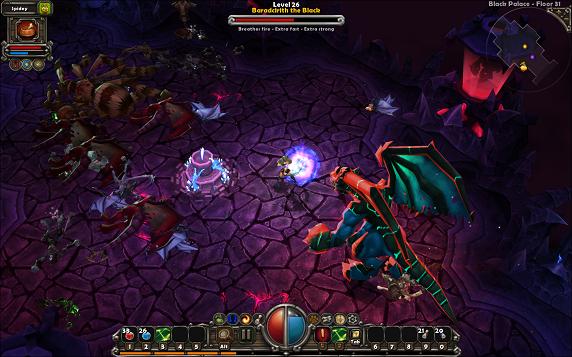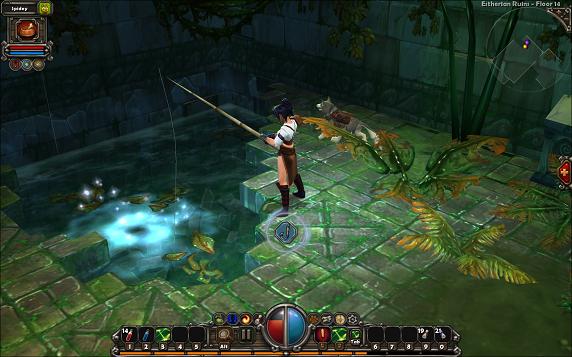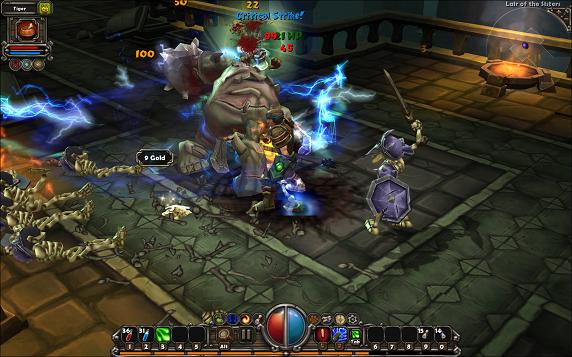
Torchlight, the first game made by Runic Games, has a storied development history. Its ancestor was a nifty little action RPG called Fate which earned plenty of praise for being a fun albeit lightweight Diablo clone. Fate however was distributed mostly by the ad network WildTangent which has a bit of a reputation for aggressively pushing advertisements onto users’ PCs and didn’t really reach a wide audience.
It was still enough of an accomplishment that Flagship Studios hired its creator Trevor Baldree to work on a project that eventually became Mythos. The story of Flagship’s flagship game Hellgate: London and its implosion is legendary by now of course, and in the aftermath the team behind Mythos opted to form their own company and start making a new game from scratch, hence Torchlight, a game that took only one year to make from conception to release.
Torchlight is best described as a Diablo clone with the art direction of World of Warcraft, so if you’ve played any action RPG before, you already know what to expect. Click, click, click on enemies until they die. Chug the appropriate potion whenever your health or mana drops low. Collect all the loot on the floor. Earn experience points and gain levels. Rinse and repeat. It’s a trite formula but it’s one that works as the countless mice worn out by playing Diablo all around the world can attest to.
The game sticks to this formula like glue, so don’t expect any surprises or innovation here. The only deviation from the Diablo model is that you get a loyal pet to accompany you on your dungeon delving activities. As in Fate, your pet can help to tank and do a bit of damage which is especially useful to weaker, non-melee characters but you can also use it as a storage mule. Simply dump loot that you’re not going to use into the pet’s inventory and when it’s fully loaded, you can order your pet to head back to town to sell them all off for cash so that you don’t have to take a break from your hacking and slashing.

The story takes place in an original world created by Runic Games. The name refers to a booming mining town that was built on top of a seemingly inexhaustible supply of Ember, a mysterious mineral with magical qualities. As the miners dig ever more deeply however, they have roused monsters who quickly overrun the mines and have even attacked the surface. No prizes for guessing that your character is one of the heroes who have answered the miners’ call for help. It’s fantasy fare at its most generic but at least it has no pretensions about being anything more than that.
Your hero can be one of three fancifully-named classes: the Destroyer, the Vanquisher or the Alchemist. Each of the classes has three distinct skill trees, so there’s some scope to customize your character. Generally however, the Destroyer is your basic, in-your-face melee warrior, the Vanquisher can either be a ranged damage dealer or a dagger-wielding close-combat fighter reminiscent of the rogue from World of Warcraft and the Alchemist is the obligatory mage, specializing either in long-ranged offensive magic or summoning minions to do his fighting for him.
All this is presented in a colorful, slightly cartoonish style that works well given the lightweight feel of the game. There’s a nice variety of monster models and cool little bits of animation, such as when you whack a bunch of skeletons with a powerful hit near a ledge and they all go flying off. What’s particularly great is that the game scales well with a variety of levels. At the high end, everything looks suitably crisp and impressive, but the graphics can be dialed down enough that it will work adequately even on a lowly netbook.
Still, the game borrows so liberally from Blizzard’s games that it borders on lawsuit filing territory, down to the life / mana orbs and the skill switching interface. The quest givers even have the familiar exclamation points over their heads! One thing that I found convenient is that you don’t have to click on piles of coins to pick them up. You automatically pick up gold on the ground when you walk over them. Everything else is familiar, sometimes quite painfully so. Is it really necessary to re-implement the Town Portal and Identify scrolls? It’s not that like these are actually finite resources.

The worst thing about the game however is that it lacks character. Diablo 2 was so exquisitely made that even nearly ten years later, I can still recall the frisson of fear when I first encountered Andariel and the crazed excitement when I first discovered the power of a well placed Corpse Explosion. None of the bosses or encounters in Torchlight are anywhere near as memorable. Since you only ever go deeper and deeper into what is supposed to be the same dungeon, it actually gets monotonous after a while.
The skill trees are boring as well. Many skills are repeated across the three classes and feel as if they’re space fillers instead of cool ideas that the designers were enthusiastic about implementing. Some of the best skills do nothing but a straightforward percentage bonus to your damage or a boost to your critical hit chance. Solid staples of the genre sure, but nothing to feel excited about.
Unsurprisingly for a game that took only a year to make, there’s also a distinct lack of polish. Ranged combat for example, feels off. Your range with most weapons is actually shorter than half of the screen area, at least on the resolution I play at, so I constantly have to walk close to monsters to shoot at them. Shooting up or down staircases also often doesn’t work as the projectiles hit the stairs instead of your targets.
All this probably makes me sound too negative about the game than I intended. In all fairness, it’s not a bad game so much as one that’s a bit pedestrian and unambitious. It gets the basics of a mindless hack and slash game right and does have its charming moments, such as when you discover that it is possible for your Alchemist to dual-wield wands or when you use the Enchanter in town to bestow random enchantments on a magical item and it ends up getting a stupidly powerful combo of abilities.

Runic Games was probably one of the few people around the world who gleefully celebrated Blizzard’s recent announcement that Diablo 3 isn’t coming out in 2010 and might not even come out in 2011. At a mere US$20, picking up Torchlight to whet your appetite is a no-brainer while you wait for the real Diablo successor to show up. Just don’t expect too much and you can a get terrific experience out of it. Their next game is supposedly an MMO version of Torchlight and while I can’t say that I’m terribly enthusiastic about the idea of yet another World of Warcraft clone, successfully delivering a game in under a year is still impressive enough of a feat that it’s worth paying attention to what these guys are up to next.
Leave a Reply